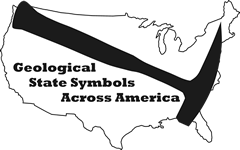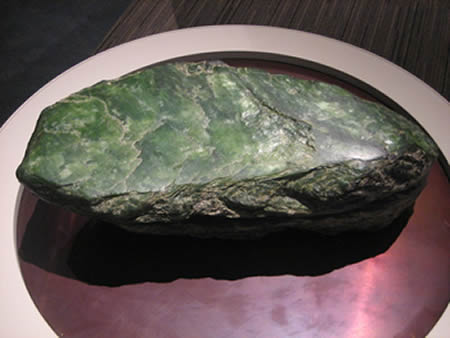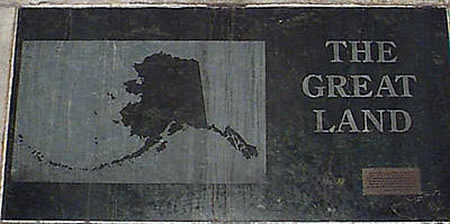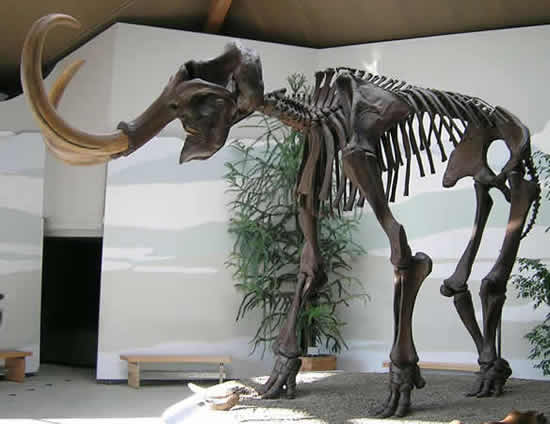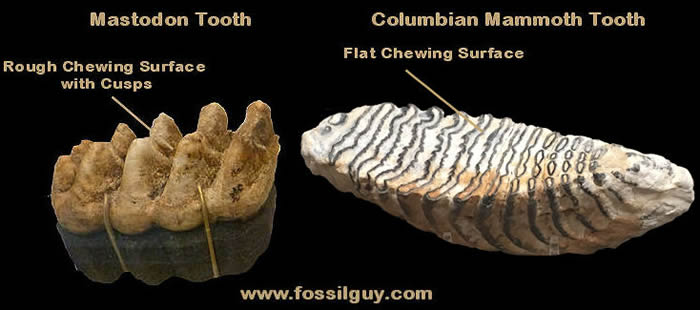Alaska
Type |
Symbol |
Year Est. |
|---|---|---|
State Mineral |
Gold |
1968 |
State Gem |
Jade |
1968 |
State Fossil |
Woolly Mammoth (Mammuthus primigenius) |
1986 |
State Mineral: Gold
SB 223 Chapter 50
AN ACT
Providing for a state mineral.
BE IT ENACTED BY THE LEGISLATURE OF THE STATE OF ALASKA:
* Section 1. AS 44.09 is amended by adding a new section to read:
Sec. 44.09.110. STATE MINERAL. Gold is the official state mineral.
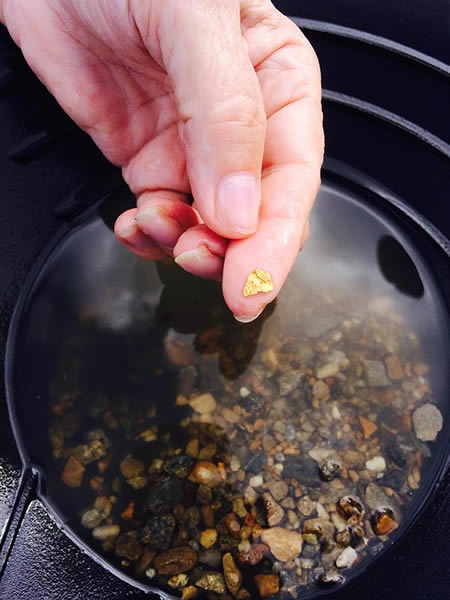
Panning for gold in Alaska. Photo from GoldDaughters.com.
The chemical symbol for gold is Au, and gold is one of the unique minerals that, in its pure form, is composed entirely of one element. It has a hardness of 2.5 to 3 on the Mohs hardness scale meaning that it actually is very soft (your fingernail is 2.5). For this reason most gold jewelry is mixed with another metal to prevent scratching and bending easily. The karat rating of the gold represents it's purity, where 24 karat is 99.9% pure, 22 karat 91.7%, 18 karat 75%, and so on. Gold naturally does not corrode or tarnish, so even when it is mixed with other metals it usually has a resistance to tarnishing, enhancing its value for jewelry. When gold is found in place, the highest grade of gold is often found in association with quartz veins. Currently gold is considered one of the most valuable metals on Earth, being used as the standard for most money (gold standard). Gold is often formed initially in relation to volcanic regions, where fluids associated with volcanoes carry the heavy metals up towards the surface and deposit them in rocks. These are found in areas of current or former subduction zones, places where two plates came together forcing one place down and melting it, while the other plate is forced upwards into mountains. Afterwards, erosion will take the gold out of the mountains and carry them down stream. However, since gold is so dense it does not travel easily down rivers and will often settle to the bottom of the river within the rocks and mud within the river sediment. These gold deposits are known as placer deposits and are the primary place where gold panners find gold. They can then use the locations of these placer deposits to backtrack to the original sources of the gold within the streams.
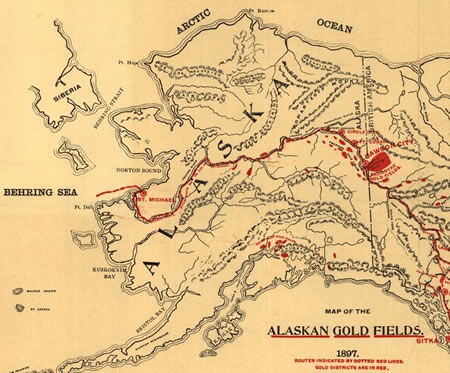
Map of the Alaskan Gold Fields from 1897. Map courtesy of the World Digital Library.
Gold has an important history in Alaska. Originally when the territory was purchased it was referred to as Steward's Folly because this big hunk of land couldn't be worth anything. That was before gold was discovered. It began in the 1870's and continued through most of the 1900's. The beginnings of many communities in Alaska got their start as gold mining towns. Today Alaska is more known for its oil exploration but gold still holds a prominent place in its heart with Fairbanks remaining as a major gold exploration area. From the 1880's to 2005, Alaska has produced ~1250 metric tons of gold. Even though gold is going by the wayside in Alaska, it is still one of the major producers of gold in the United States, producing the second most gold after Nevada for the last decade. To the left is the major gold mines up to 1897, which follows a similar pattern of known gold deposits today, with a large swath of gold mines spread across the central portion of the country. One of the locations that gold was originally discovered was a placer deposit within the Yukon River and several mines of gold have been discovered from there, expanding ever outwards from the central strip.
Related: California State Mineral - Gold; North Carolina State Mineral - Gold; South Dakota State Jewlery - Black Hills Gold
State Gem: Jade
SB 222 Chapter 51
AN ACT
Providing for a state gem.
BE IT ENACTED BY THE LEGISLATURE OF THE STATE OF ALASKA:
* Section 1. AS 44.09 is amended by adding a new section to read:
Sec. 44.09.100. STATE GEM. Jade is the official state gem.
An example of the jade variety of "Nephrite". Photo courtesy of the International Gem Society.
Jade is a green gemstone that has a bit of an ambiguous mineralogy. It turns out that samples of gemstones that have been called jade actually fall into three different mineral categories. Typically what happens with gemstones, is that they are a name of a specific colored mineral; i.e. purple quartz is known as amethyst. Well in this instance the green gemstone jade can be one of three minerals: jadeite, actinolite, or tremolite. And even the combination of actinolite and tremolite goes by a different name: nephrite.
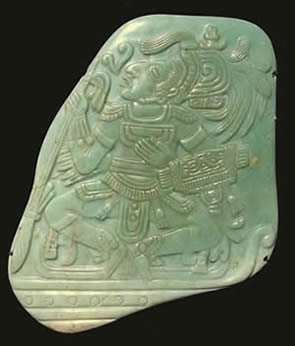
An example of a carved piece of Jade. Photo by John Hill through Wiki Commons.
There is a strong physical similarity between all these minerals, hence the confusion of which mineral jade could belong to and so all of these, as long as they are green, can be considered jade. All of these minerals have a hardness of 6 to 7 on Mohs Hardness Scale and all are silicates, although with significantly different chemical formulas. Jadeite is a aluminum-rich pyroxene (NaAlSi2O6) and actinolite and tremolite are magnesium-rich amphiboles (Ca2(Mg,Fe)5Si8O22(OH)2). All three of these minerals are formed through the process of metamorphism. Jadeite is a metamorphosed variety of albite, a plagioclase mineral and actinolite/tremolite are commonly formed from the metamorphism of ultramafic and mafic igneous rocks, such as those formed in oceanic crust. Due to the durability of the jade minerals, they can be formed into tools, however the green color has caused many artisans to use them more for jewelry and sculptures (such as the Mayan jade sculpture to the right).
The Jade plaque located within the Washington Monument in Washington D.C. Photo courtesy of Sit News.
Alaska has large deposits of jade throughout the state but its principle claim to fame is an entire mountain made out of jade, aptly named Jade Mountain. The mountain is located far from any road, north of the Arctic Circle, near Kobuk. Very large blocks have been taken out of the mountain and used to create statues including a 3,600 lb block for a police memorial statue in Fairbanks. Currently, jade statues and jewelry produced from Alaska's famed Jade Mountain can be found all over the world, including a plaque embedded in the Washington Monument (pictured left). The mineral tremolite, which is one of the mineral varieties of jade, also can form another similar mineral, asbestos. It is the asbestos from Jade Mountain that received much of the commercial interest in the early days, of the modern "discovery" of the mountain (despite it being known about for thousands of years by the local Eskimos). The jade from Jade Mountain is the nephrite variety, however the amount of jade is dwarfed by the amount of tremolite asbestos in the region, and the quality is often not good enough to be considered gem grade. However, enough of the jade has been mined and used as jewelry and sculptures to warrant recognition. The age of the original, premetamorphosed ultramafic and mafic rocks, are Early to Middle Jurassic. These rocks were likely metamorphosed from contact with hydrothermal fluids associated with plate tectonics along the ocean floors and serpentinized. Eventually, plate tectonics along the convergent plate boundaries caused these deep ocean deposits to be uplifted into the Brooks Range (the mountain range where Jade Mountain is located).
Related: Wyoming State Gemstone - Jade
State Fossil: Woolly Mammoth (Mammuthus primigenius)
SB475
4/10/86
Resources
BY THE RESOURCES COMMITTEE
IN THE SENATE
SENATE BILL NO. 475
IN THE LEGISLATURE OF THE STATE OF ALASKA
FOURTEENTH LEGISLATURE - SECOND SESSION
A BILL
For an Act entitled:
"An Act designating the woolly mammoth as the state fossil."
BE IT ENACTED BY THE LEGISLATURE OF THE STATE OF ALASKA:
* Section 1. LEGISLATIVE INTENT. By designating the woolly mammoth as the state fossil, the legislature intends to give recognition to this animal that was the largest and one of the most prevalent animals in the state but whose remains are now found only as fossils. *
Sec. 2. AS 44.09 is amended by adding a new section to read:
Sec. 44.09.120. STATE FOSSIL. The woolly mammoth is the official state fossil.
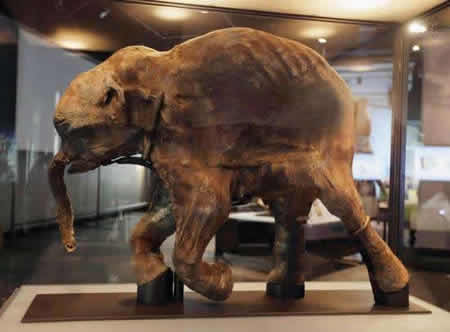
The preserved remains of Lubya, a baby mammoth from Siberia. Image from Britannica.com.
The Woolly Mammoth, also known as Mammuthus primigenius, is a species closely related to modern day elephants. One notable difference between the extinct species and the modern day elephant is that the mammoth notably was covered with hair, allowing it to thrive in the arctic environments of modern day Alaska, Siberia, and Canada. Unlike most of the other state fossils, mammoths are frequently found as complete specimens, such as the complete baby mammoth found from Siberia (image on the left). They are usually frozen in the snow or buried in an Arctic swamp. One of the common questions that comes up when discussing mammoths, is "What is the difference between a mammoth and a mastodon?". Although they are fairly closely related, and all related to modern day elephants, there are a few significant differences between the two species. The easiest feature to identify in a fossil specimen is the huge difference in their teeth (pictured below). These differences were due to the way that they ate their food. The cone-shaped molars of the mastodon were used to crush leaves, twigs, and branches, while the flatter ridged molars of the mammoth were used to cut through vegetation and graze similar to modern day elephants.
Comparison of the teeth of a mammoth versus a mastodon. Image from the FossilGuy.com.
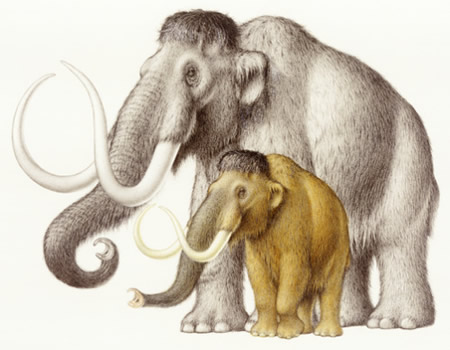
Size comparison of an island dwarf mammoth compared to a "normal" sized mammoth. Photo from the Daily Curiosity.
Most of the ~100 remains of fully preserved mammoths have been found in Russia and Alaska. Mammoth remains are found throughout the northern reaches of the state as well as scattered throughout other regions. The local prehistoric people were known to have had interactions with the mammoths. Evidence includes tools that were created from their tusks. It is believed that these interactions with prehistoric humans are what drove the mammoths into extinction. A small island off the coast of Alaska is also one of the last remaining locations where woolly mammoths lived (until ~3,750 BC). Since the island was small the mammoths that have been found here evolved into dwarf varieties of the typical continental mammoths (pictured right).
Related: Nebraska State Fossil - Mammoth; South Carolina State Fossil - Columbian Mammoth; Vermont State Terrestrial Fossil - Mount Holly Mammoth Tooth & Tusk; Washington State Fossil - Columbian Mammoth
References
https://statesymbolsusa.org/states/united-states/alaska
http://www.commerce.state.ak.us/ded/dev/student_info/student.htm
http://www.eed.state.ak.us/temp_lam_pages/library/goldrush/index.htm
http://alaska.gov/kids/student_printer.htm
http://www.alaskascenes.com/alaskagold.html
https://www.wdl.org/en/item/13496/
https://www.nr.gov.nl.ca/nr/mines/outreach/education/gold.html
https://www.goldmapsonline.com/alaska-gold-mines-yesterday-today.html
http://www.sitnews.us/JuneAllen/AlaskaJade/100504_jade_mountain.html
https://geology.com/gemstones/jade/
https://www.gemsociety.org/article/nephrite-jewelry-and-gemstone-information/
https://en.wikipedia.org/wiki/File:Mayan_Jade.jpg
http://dggs.alaska.gov/webpubs/dggs/pn/text/pn003r.pdf
http://www.nature.com/nature/journal/v429/n6993/full/nature02612.html
http://www.shgresources.com/ak/symbols/fossil/
http://thedailycuriosity.tumblr.com/post/9277019095/a-dwarfed-form-of-the-woolly-mammoth-lived-on
https://www.britannica.com/animal/woolly-mammoth
https://www.fossilguy.com/sites/peace-river/peace-river-fossils.htm
https://www.livescience.com/34446-mammoth-or-mastodon.html
https://en.wikipedia.org/wiki/Woolly_mammoth
http://www.akleg.gov/basis/folio.asp
Geology of Alaska's National Parks
Through Pictures
(at least the one's I have been to)
None yet!

